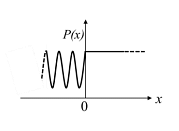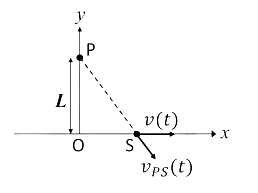For a simple pendulum, a graph is plotted between its Kinetic Energy (KE) and Potential Energy (PE) against its displacement d. Which one of the following represents these correctly? (graphs are schematic and not drawn to scale)
The Correct Option is A
Solution and Explanation
Both graphs are parabola. At d = 0, the mean position PE = 0 and $KE=\frac{1}{2}m \omega^2 A^2 $ =maximum
At $d=?A,$ the extreme positions,
KE = 0 and $PE=\frac{1}{2}m \omega^2 A^2$ =maximum
Therefore, the correct graph is (a).
Top Questions on Oscillations
- The period of oscillation of system shown below is \(π\sqrt{\bigg(\frac{\alpha M}{5K}\bigg)}\) then \(\alpha\) is

- JEE Main - 2024
- Physics
- Oscillations
- Which of the following types of motion may be represented by the trajectory,
𝑦(𝑥)=𝑎𝑥 2+𝑏𝑥+𝑐 ?
(Here a, b, and c are constants; x, y are the position coordinates)- IIT JAM - 2024
- Physics
- Oscillations
- A particle moving along the x-axis approaches 𝑥=0 from 𝑥 =−∞ with a total energy E. It is subjected to a potential 𝑉(𝑥). For time 𝑡→∞, the probability density P(x) of the particle is schematically shown in the figure.

The correct option for the potential 𝑉(𝑥) is:- IIT JAM - 2024
- Physics
- Oscillations
- If two traveling waves, given by
𝑦1=𝐴0 sin(α𝑘𝑥 -𝜔𝑡) and 𝑦2=𝐴0 sin(α𝑘𝑥 − β𝜔𝑡)
are superposed, which of the following statements is correct?- IIT JAM - 2024
- Physics
- Oscillations
- A whistle S of sound frequency f is oscillating with angular frequency 𝜔 along the x-axis. Its instantaneous position and the velocity are given by 𝑥(𝑡) = 𝑎 sin(𝜔𝑡) and 𝑣(𝑡)=𝑣0 cos (𝜔𝑡), respectively. An observer P is located on the y-axis at a distance L from the origin (see figure). Let 𝑣𝑃𝑆(𝑡) be the component of 𝑣(𝑡) along the line joining the source and the observer. Choose the correct option(s):
(Here 𝑎 and 𝑣0 are constants)
- IIT JAM - 2024
- Physics
- Oscillations
Questions Asked in JEE Advanced exam
- A region in the form of an equilateral triangle (in x-y plane) of height L has a uniform magnetic field 𝐵⃗ pointing in the +z-direction. A conducting loop PQR, in the form of an equilateral triangle of the same height 𝐿, is placed in the x-y plane with its vertex P at x = 0 in the orientation shown in the figure. At 𝑡 = 0, the loop starts entering the region of the magnetic field with a uniform velocity 𝑣 along the +x-direction. The plane of the loop and its orientation remain unchanged throughout its motion.

Which of the following graph best depicts the variation of the induced emf (E) in the loop as a function of the distance (𝑥) starting from 𝑥 = 0? - Two beads, each with charge q and mass m, are on a horizontal, frictionless, non-conducting, circular hoop of radius R. One of the beads is glued to the hoop at some point, while the other one performs small oscillations about its equilibrium position along the hoop. The square of the angular frequency of the small oscillations is given by [ \(\epsilon_0 \)is the permittivity of free space.]
- JEE Advanced - 2024
- Moving charges and magnetism
- A group of 9 students, s1, s2,…., s9, is to be divided to form three teams X, Y and Z of sizes 2, 3, and 4, respectively. Suppose that s1 cannot be selected for the team X and s2 cannot be selected for the team Y. Then the number of ways to form such teams, is _______.
- JEE Advanced - 2024
- Combinations
- Let \(\vec{p}=2\hat{i}+\hat{j}+3\hat{k}\) and \(\vec{q}=\hat{i}-\hat{j}+\hat{k}\). If for some real numbers α, β and γ we have
\(15\hat{i}+10\hat{j}+6\hat{k}=α(2\vec{p}+\vec{q})+β(\vec{p}-2\vec{q})+γ(\vec{p}\times\vec{q})\),
then the value of γ is ________.- JEE Advanced - 2024
- Vector Algebra
- Let X be a random variable, and let P(X = x) denote the probability that X takes the value x. Suppose that the points (x, P(X = x)), x = 0,1,2,3,4, lie on a fixed straight line in the xy -plane, and P(X = x) = 0 for all x ∈ R - {0,1,2,3,4}. If the mean of X is \(\frac{5}{2}\) , and the variance of X is α, then the value of 24α is ______.
- JEE Advanced - 2024
- Probability
Concepts Used:
Oscillations
Oscillation is a process of repeating variations of any quantity or measure from its equilibrium value in time . Another definition of oscillation is a periodic variation of a matter between two values or about its central value.
The term vibration is used to describe the mechanical oscillations of an object. However, oscillations also occur in dynamic systems or more accurately in every field of science. Even our heartbeats also creates oscillations. Meanwhile, objects that move to and fro from its equilibrium position are known as oscillators.
Read More: Simple Harmonic Motion
Oscillation- Examples
The tides in the sea and the movement of a simple pendulum of the clock are some of the most common examples of oscillations. Some of examples of oscillations are vibrations caused by the guitar strings or the other instruments having strings are also and etc. The movements caused by oscillations are known as oscillating movements. For example, oscillating movements in a sine wave or a spring when it moves up and down.
The maximum distance covered while taking oscillations is known as the amplitude. The time taken to complete one cycle is known as the time period of the oscillation. The number of oscillating cycles completed in one second is referred to as the frequency which is the reciprocal of the time period.







